How To: Start Downrigging
Want to catch more fish... bigger fish! here’s how you can do it too...
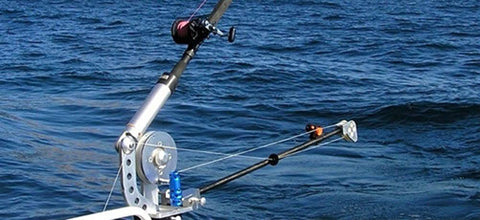
Many years ago I spent a week fishing for barramundi on Bathurst Island, in the Northern Territory. My guide for the week, Brett, didn’t have much formal education, but was wise to the ways of fish. He had been brought up on a mackerel boat based in Wyndham, and had packed thousands of hours of fishing into his young life. Each morning, Brett and I would leave before dawn to fish for Spanish mackerel around the rocky headlands just off-shore. The mackerel came on the bite at first light, and disappeared about an hour after dawn. One day, I asked Brett why these big predators were so predictable, as regards their main hunting period.
Brett opened his tackle box and picked up a long minnow lure to explain. ‘Andy, all bait fish, no matter what type, have something in common: a dark back, blue, black or green. And a light coloured underside, silver, white or cream. The sea birds that hunt them from the air look down from above, and find it hard to distinguish the dark backs from the dark coloured water. The big fish that hunt them from below look up and find it hard to distinguish their silver bellies from the bright light above.
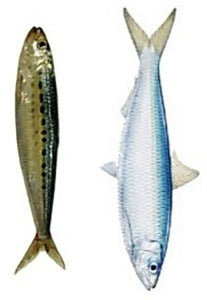
It’s only at dawn and dusk, when the sun is at an acute angle to the water, that light reflects off the side of the bait fish, making hunting them easier. And dawn is usually better than dusk because the seas are calmer, early in the morning.’
Brett’s insights were spot on. When the early morning feeding opportunity has passed, mackerel take up station over deep reefs. Yellowtail kingfish, which occupy the Spanish mackerel’s place in the food chain around the southern half of Australia, do the same thing. During the middle of the day they’re the same aggressive predators, but like all predators conserve energy when not hunting. Yet if a bait or lure is placed deeper in the water, close to where the fish are on station, a strike will usually result.
This is where downriggers come in. By using a downrigger, in combination with a depth sounder, you can present your bait or lure to fish marking on your screen or at the correct depth where fish are likely to be holding. In waters adjoining major metropolitan centres, or popular fishing spots, predators will tend to hold deeper and get on station earlier because they don’t like boat traffic. This is why fishing in Sydney Harbour is often better midweek, than on weekends. With downriggers you can still produce fish in the middle of the day in Australia’s busiest waterways.

Downriggers come in all shapes and sizes. The technique was first popularised in the USA, originally used to target salmon and large trout in the Great Lakes. I went on a downrigging charter on Lake Michigan, near to the Illinois / Wisconsin border. That kind of fishing is radically different to Australian conditions. With cheap fuel much larger boats are used. We fished from a 40 foot express which had a transom at least 12 feet across. The boat had no marlin board, no motor legs and no outboards (shaft drive) allowing the use of multiple downriggers which were easily managed. The Great Lakes are freshwater, so corrosion is not a concern. And through summer, the Lakes are very calm. Lake Michigan was calm, during the week we fished.

All very different, to Australian conditions. Here, the average size boat is 5 or 6 metres long. The combination of strong sunlight and salt water makes corrosion a serious concern. Our seas are often rough, meaning a strong, robust downrigger is needed. Most boats are powered by outboards, meaning a long downrigger boom is required to keep the gear away from the propeller.
That’s why, our downrigger is built for the toughest Australian conditions.
Features include:
1. A one metre boom, to keep everything clear of the prop, even when you’re making tight turns
2. A lock up/lock down tilting boom, making the downrigger easy to store

3. 200 feet of 200-pound 100% Dyneema braid (more available on request). Braid is so much better than steel cable. It offers less water resistance meaning that in most cases you can use lighter weights. It’s not susceptible to corrosion. But most of all, it doesn’t deposit large amounts of caked salt on your spool the way cable does particularly, nylon coated cable.
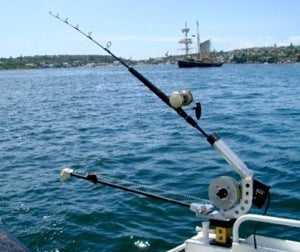
4. An adjustable four angle rod holder, fitted with crosspin to lock your rod in securely. We warranty the rod holder for 5 kilos of drag. It should be okay for more than that, but if using heavy gear attach a lanyard to the lugs on your reel.

5. A detachable resettable depth counter, which measures depth down to 1000 metres. It attaches to the boom of your downrigger with a stainless steel clip. This is a fantastic little product on its own, also very handy for measuring the amount of line on your fishing reel spools when topping up, it will fit any rod and most downriggers.
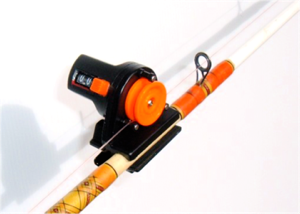
6. A swivelling downrigger boomhead, with internal stainless steel needle bearings. This helps in keeping your cable and line straight when making tight turns – for instance, when you’ve marked fish on your sounder, and want to do a hard 180 to get back to them.
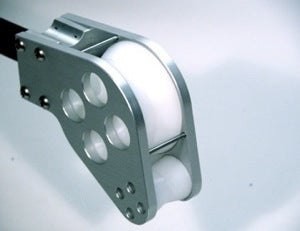
7. A clockwise only winding handle, with ratchet clicker.
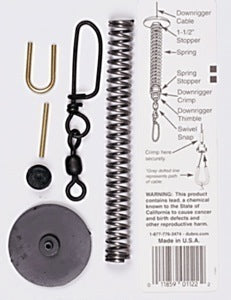
8. A powerful drag using Carbontex game reel washers. The drag will hold a 20 pound plus weight easily, but will release if your bomb hangs up on a reef or FAD cable.

9. All aluminium construction, with stainless steel fittings. Non conductive paste is applied to the fastenings to prevent galvanic corrosion.
We have two options available, for mounting.
- The first is a solid (not hollow) gimbal mount that fits in your boats rod holder.
This is a great way to go because, when not in use, the downrigger can be stored in your rod rack. It weighs about the same as a regular 80-pound outfit. Note that the boat rod holders should be metal rather than plastic.

- The second mounting option is a three piece detachable sliding base. With this system, one plate is mounted on the transom of your boat, another up the front or in the cabin where your downrigger will be stored. The third grooved piece is bolted to the bottom of your downrigger. A locking pin is fitted to ensure secure storage or use.

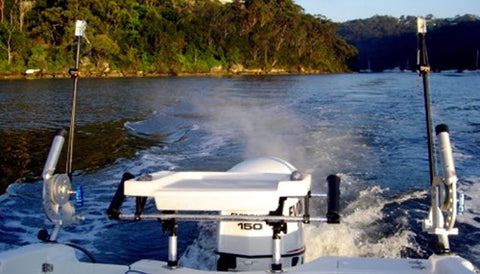
Like to know more, or want to place an order?
Please call Andrew or send an e-mail.
or click here to see our downrigger page.
Thanks for reading